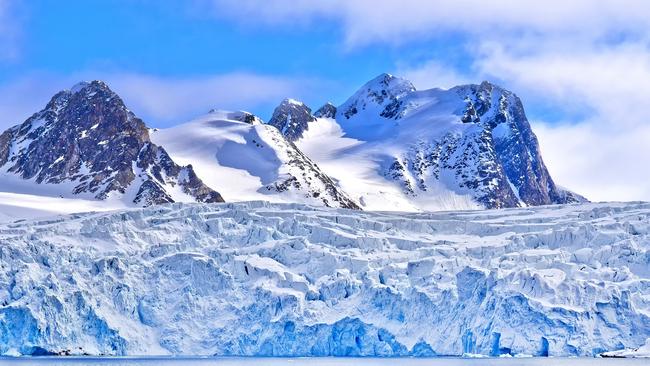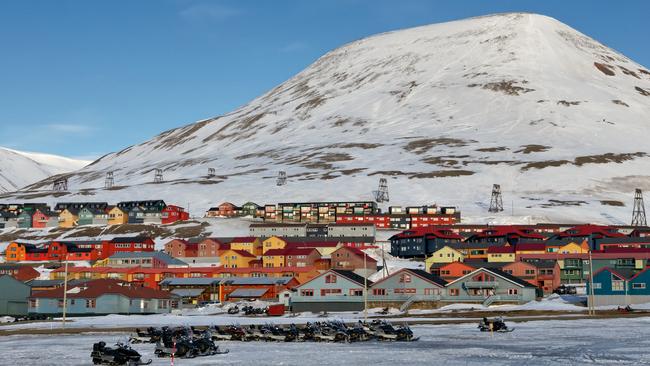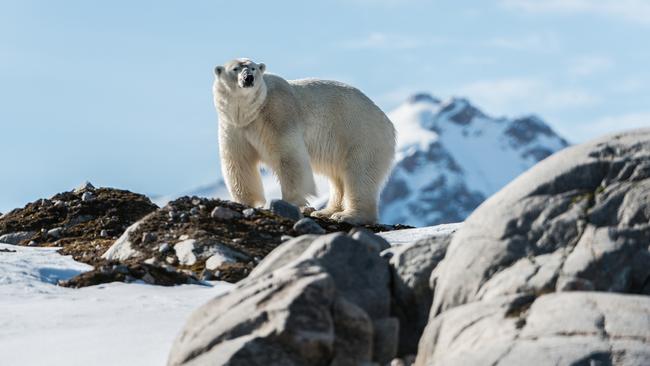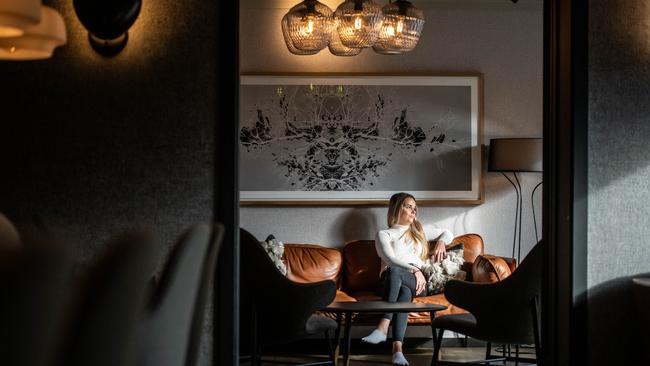Life in the raw on Norway’s Svalbard archipelago
Raw, real and home to roughly 3000 polar bears, this remote mountainous archipelago is the kind of place that gets under your skin.

A sign at the entrance to the supermarket in Longyearbyen forbids shoppers from bringing their rifles or pistols into the shop. On the outskirts of town, another sign emblazoned with a red and black triangle warns against venturing beyond without an armed guide. Sled hounds are kept in kennels surrounded by high wire fences. No one locks their car or house in case a passer-by suddenly needs to take shelter. And trekkers pitching camp further afield set up trip wires, use guard dogs and assign night-watch duties to keep themselves safe.
The presence of polar bears casts a spectre over life in Svalbard, the remote mountainous archipelago halfway between Norway and Greenland. About 3000 of these apex predators live on the islands. They roam the pack and sea ice, hunting mainly ringed and bearded seals, but they’re not fussy; rotting whale carcasses, arctic fox, kelp and berries are all on the menu.
It would be a foolish human who stood between them and their dinner.
During my short stay in Longyearbyen, the largest town on the island of Spitsbergen, everything I learn about these animals inspires awe, and more than a little fear. Polar bears can sniff out a seal on the ice from 32km, a distance of little concern given they can walk 80km a day and swim up to 60km. The giant paws of an 800kg male leave prints 25cm wide. And while mating season typically runs from March to May, females can hit the pause button on a pregnancy for five months to ensure they eat enough food to make it viable.
We know so much about these formidable creatures these days that attempts by the 16th-century Dutch navigator and cartographer Willem Barents and his crew to catch a live specimen seem ludicrously uninformed. Barents sailed three expeditions between 1594 and 1596, trying to find a northeast passage from the Arctic to China. He discovered Bear Island and Spitsbergen in the process, and ultimately succumbed to a no-doubt unpleasant combination of exposure and scurvy. Historical etchings in the Svalbard Museum show men in a flimsy rowboat trying to drag a lassoed bear on board (apparently, they thought it would fetch a good price in China) and fending off another’s claws and fangs with spears. What were they thinking?

On a scenic cruise from Longyearbyen to Nordenskioldbreen glacier, the wind slices through my down jacket and whips up an icy chop on the Isfjorden as seabirds wheel overhead. It’s about 1C but feels like minus 10C. Ice-carved mountains rear from the water’s edge, their strata-striped sides streaked with white, like vanilla ice-cream melting down a cone. I’m lucky to have arrived soon after autumn’s first snowfalls, which provide a gleaming contrast to the barren, rocky terrain. At such a high latitude (Longyearbyen sits at 78 degrees north, less than 1400km from the north pole), Svalbard has little in the way of vegetation. Somehow, reindeer manage to scratch out an existence, and are often spotted grazing in town. Sixty per cent of the land mass is covered in glaciers, but elsewhere a bleak colour scheme of brown, grey and black prevails.
Austrian writer Christiane Ritter, who spent a year in Svalbard in 1933 with her husband, a hunter, wrote bitterly of the scraggy moonscape in A Woman in the Polar Night. “Stone after stone, I am now seeing stones in my sleep and when I’m awake. They are going to get on my nerves; I can feel it. This stony land, the total gigantic barrenness, is going to haunt me as a bad dream.”

We sail past a wooden boat listing on its side on the shore, and a lonely hut, the ghostly remains of a gypsum mining operation. Pyramiden, a lucrative Russian coalmining settlement that was abandoned in 1998, stands on the edge of the fjord, a ghostly reminder of times past.
The stubby dorsal fin of a juvenile minke whale arcs back and forth across MS Bard’s path. Our guide, Fred, explains this is unusual behaviour for a species that is notoriously shy, unlike its southern hemisphere siblings. He theorises that the northern minkes’ reticence is due to their collective memory of Svalbard’s bloody past.
Barents had noted the abundance of whales, seals and walrus in the archipelago during his expeditions and, in the early 1600s, whalers arrived to feed a growing demand for oil. The rich waters were plundered for almost 200 years until stocks were almost exhausted.
Then came the hunters and trappers. Arctic fox and polar bear were their main quarry. In the museum, black and white photos show beasts spreadeagled and lifeless on the ice, hunters standing proudly by their catch. Also on display is the rifle of trapper Georg Nilsen who went missing in 1921. More than 40 years later, the rifle was found next to human remains, a cartridge jammed in its chamber. It’s estimated 30,000 polar bears were killed in the century before protection laws were enacted in 1973. The word “karma” springs to mind.

So there is great excitement when the captain brings our boat to a halt and we are advised to train our eyes on a patch of snow ashore. A polar bear smeared with red is tucking into a reindeer. We learn the animal was spotted the previous day in the same spot, the same dish on the menu. Fred says he hopes this unusual behaviour is a positive sign of adaptation. Svalbard’s average temperatures have risen more than 5C since the 1970s, reducing significantly the time bears can hunt on the sea ice. Scientists have recorded them spending more time on glaciers; learning to ambush reindeer is a new skill. “There have been many indications of their habits changing,” Fred says. “This is quite a good sign for them.”
Back on dry land, as fat flakes of snow flutter down, I explore Longyearbyen. Named after American John Munro Longyear, the man who started coalmining here in 1906, it’s an otherworldly frontier town. Evidence of its industrial past is everywhere, from tumbling weather-beaten timber structures to the empty coal baskets of the aerial tramway swaying sadly in the wind.
There’s a sophistication to the place, though. With a population of 2300 encompassing about 70 nationalities, this is a community where people have to get along and support one another, especially during the long, dark days and nights of winter when temperatures plummet to minus 40C. I’m staying at the funky Funken Lodge, named for the “functionaries” or mine managers who used to bed down here. The property emerged from a refurbishment in 2018 as a slick 88-room hotel that wouldn’t look out of place in Oslo. Leather lounges, plush rugs, sleek timber furniture and groovy pendant lights create a cosy, inviting ambience. Shoes are dispensed with at the entrance, so guests pad about in socks or slippers, adding to the sense of homeliness. Its restaurant, Funktionarmessen, is regarded as one of the best in town.
I order a beer down the road at Karlsberger Pub, which has one of the most impressive arrays of Scotch whiskies I’ve seen anywhere, let alone this side of the Arctic Circle. I’m surprised to spot several varieties of Four Pillars gin on the shelf, plus a connoisseur’s collection of Armagnac.
In one of the town’s many outdoor gear shops (which stock weapons and ammunition alongside hiking boots and sleeping bags), I ask the attendant for a dinner recommendation. He sends me to Polfareren in the Svalbard Hotel, where scallop ceviche, wild boar, reindeer and pan-fried cod are dished up with Japanese flourishes, served by a young gent from The Philippines, who assures me in flawless English that learning Norwegian has been easy.
On my last night, a taxi deposits me and a handful of other tourists at Camp Barentz, a log cabin well outside the town limits. We’re met by Solvi, a young woman with a flare gun holstered on her hip and a rifle slung over her shoulder. A polar bear and her cub have been spotted in the vicinity in recent weeks, but even if they hadn’t, Solvi would still be armed and alert. She spent 11 years working as a nurse in Oslo before swapping her scrubs for sturdy boots and winter woollies. Now she’s here, stirring a steaming pot of reindeer soup over a wood fire, watching for bears while her guests use the amenities in an adjacent hut, and sharing the extraordinary stories of this alien place.
“My family has kind of stopped asking me when I will come home,” she says.
Svalbard is that kind of place – raw and real. It gets under your skin and given time, I’m sure would penetrate your heart and mind. After only three days here, I am devastated to leave without the chance to experience a long, brutal winter, to see the northern lights, to take a dogsled ride in the snow, cheeks stinging in the freezing cold. It’s as though I’m in mourning for a land I’ll never know.
In her memoir, Christiane Ritter wrote: “I feel close to Nature’s inner being and watch trails woven together, but still passing each other following eternal laws. I am catching glimpses of the last great mystery. In front of it all, human reasoning will disappear into nothing.”
Penny Hunter was a guest of Hurtigruten
Svalbard.
In the know
Norwegian cruise line Hurtigruten offers three-day stays in Longyearbyen as part of its 10-day Svalbard Express itineraries, north and southbound, between June and September.
Ships sail between Bergen in the southwest and Longyearbeyen in the far north. Starting from $5751 a person, twin-share.
hurtigruten.com/destinations/norway/svalbard-express-northbound
hurtigruten.com/destinations/norway/svalbard-express-southbound
Hurtigruten Svalbard has a range of packages with accommodation at Funken Lodge or the Radisson Blu Polar Hotel. A three-night Christmas itinerary includes cultural and history experiences, two northern lights outings, including one at Camp Barentz, Christmas dinner and an additional four-course dinner at Funktionarmessen Restaurant. December 23-26; 13,950 kroner ($2870) twin-share; solo travellers, 14,850 kroner; includes return flights from Oslo.


To join the conversation, please log in. Don't have an account? Register
Join the conversation, you are commenting as Logout